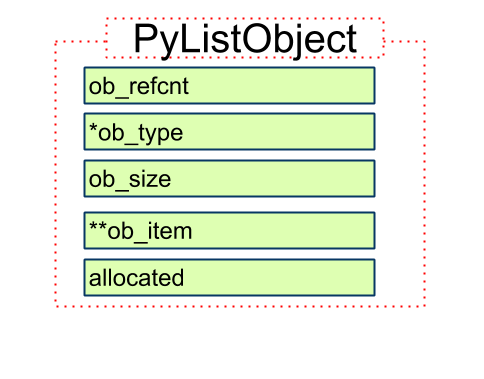源码位置 Include/listobject.h | Objects/listobject.c
定义
typedef struct {
PyObject_VAR_HEAD
PyObject **ob_item;
Py_ssize_t allocated;
} PyListObject;
说明
1. PyObject_VAR_HEAD
PyListObject是变长对象
2. PyObject **ob_item;
指向列表元素的指针数组, list[0] 即 ob_item[0]
3. Py_ssize_t allocated;
allocated列表分配的空间, ob_size为已使用的空间
allocated 总的申请到的内存数量
ob_size 实际使用内存数量
等式:
0
结构

构造
只有一个方法
定义如下
PyObject *
PyList_New(Py_ssize_t size)
{
PyListObject *op;
size_t nbytes;
#ifdef SHOW_ALLOC_COUNT
static int initialized = 0;
if (!initialized) {
Py_AtExit(show_alloc);
initialized = 1;
}
#endif
// 大小为负数, return
if (size 0) {
PyErr_BadInternalCall();
return NULL;
}
// 如果大小超过, 报错
/* Check for overflow without an actual overflow,
* which can cause compiler to optimise out */
if ((size_t)size > PY_SIZE_MAX / sizeof(PyObject *))
return PyErr_NoMemory();
// 计算需要的字节数(PyObject指针数组)
nbytes = size * sizeof(PyObject *);
// 如果缓冲池非空, 从缓冲池取
if (numfree) {
// 取缓冲池数组最后一个对象
numfree—;
op = free_list[numfree];
// set refcnt=1
_Py_NewReference((PyObject *)op);
#ifdef SHOW_ALLOC_COUNT
count_reuse++;
#endif
} else {
// 否则, GC_New分配内存空间
op = PyObject_GC_New(PyListObject, &PyList_Type);
// 分配失败
if (op == NULL)
return NULL;
#ifdef SHOW_ALLOC_COUNT
count_alloc++;
#endif
}
// 确定ob_item列表元素指针的值
// 若大小
if (size 0)
op->ob_item = NULL;
else {
// 分配内存
op->ob_item = (PyObject **) PyMem_MALLOC(nbytes);
if (op->ob_item == NULL) {
Py_DECREF(op);
return PyErr_NoMemory();
}
// 初始化, 填充
memset(op->ob_item, 0, nbytes);
}
// ob_size = size
Py_SIZE(op) = size;
// allocated
op->allocated = size;
// gc用
_PyObject_GC_TRACK(op);
return (PyObject *) op;
}
简化步骤
1. 判断列表缓冲池是否为空, 是的话从缓冲池取(复用)
2. 否则, 从内存中分配空间
3. 然后初始化数据
结论
Py_SIZE(op) = size;
op->allocated = size;
第一次生成list, 其allocated = ob_size
list_resize
同时注意list_resize方法
extends方法, list_resize(self, m + n)
pop方法, list_resize(self, Py_SIZE(self) – 1)
append方法, list_resize(self, n+1)
其定义
list_resize(PyListObject *self, Py_ssize_t newsize)
{
………..
// 如果 allocated/2 <= newsize <= allocated
// 直接修改ob_size
if (allocated >= newsize && newsize >= (allocated >> 1)) {
assert(self->ob_item != NULL || newsize == 0);
Py_SIZE(self) = newsize;
return 0;
}
//否则
new_allocated = (newsize >> 3) + (newsize < 9 ? 3 : 6);
new_allocated += newsize;
………….
Py_SIZE(self) = newsize;
self->allocated = new_allocated;
}
即
if allocated/2 <= newsize <= allocated
allocated 不变
ob_size = newsize
else
allocated = newsize + ((newsize >> 3) + (newsize < 9 ? 3 : 6))
ob_size = newsize
回收和PyListObject对象缓冲池
看下缓冲池相关的定义
/* Empty list reuse scheme to save calls to malloc and free */
#ifndef PyList_MAXFREELIST
#define PyList_MAXFREELIST 80
#endif
// 80个
static PyListObject *free_list[PyList_MAXFREELIST];
static int numfree = 0;
我们先看下list_dealloc的定义
static void
list_dealloc(PyListObject *op)
{
Py_ssize_t i;
PyObject_GC_UnTrack(op);
Py_TRASHCAN_SAFE_BEGIN(op)
// 遍历ob_item, 释放所有类表内元素空间
if (op->ob_item != NULL) {
/* Do it backwards, for Christian Tismer.
There’s a simple test case where somehow this reduces
thrashing when a *very* large list is created and
immediately deleted. */
i = Py_SIZE(op);
while (—i >= 0) {
Py_XDECREF(op->ob_item[i]);
}
PyMem_FREE(op->ob_item);
}
// 如果free_list还没满, PyListObject加入到列表中
if (numfree tp_free((PyObject *)op);
Py_TRASHCAN_SAFE_END(op)
}
即
对一个列表对象PyListObject, 回收时, ob_item会被回收, 其每个元素指向的对象引用–1.
但是PyListObject对象本身, 如果缓冲池未满, 会被放入缓冲池, 复用
缓冲池结构

List的操作过程
插入
1. resize n+1
2. 确定插入点
3. 插入点后所有元素后移
4. 执行插入
示例
>>> a = [1, 2, 3]
>>> a.insert(0, 9)
>>> a
[9, 1, 2, 3]
append
1. resize n+1
2. 放入最后一个位置(ob_size)
示例
>>> a = [1, 2, 3]
>>> a.append(4)
>>> a
[1, 2, 3, 4]
extend
1. 计算两个list大小 m n
2. resize m+n(此时本身被复制)
3. 遍历长度为n的数组, 从ob_item+m的位置开始加入
示例
>>> m = [1, 2, 3]
>>> n = [4, 5]
>>> m.extend(n)
>>> m
[1, 2, 3, 4, 5]
删除
1. 找到要删除元素位置
2. 删除之, 后面元素前移
示例
>>> a = [1, 2, 3, 2]
>>> a.remove(2)
>>> a
[1, 3, 2]
- 随机文章
标签云集
-
ui设计
android
linux
ios
docker命令
nginx
设计灵感
jupyter
Java
python插件
iphone x
大数据可视化
分布式
app设计
MySQL小知识
网页设计
docker
移动端识别
mysql优化
css
swoole
docker的使用
前端技术
APP UI设计
APP设计参考
php
golang小技巧
设计教程
logo
docker小技巧
前端开发
vue小技巧
数据库
python
vue
electron开发
页面设计
javascript
图标设计
交互设计
mysql
webpack
react
JavaScript小技巧
PHP小技巧
k8s
zabbix
Redis
树莓派
adobe



